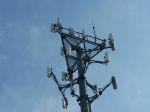Obviously, when your phone’s GPS receiver is on, your location within 30 feet or so is usually available.

There’s another way that remotes, your cellular service provider, 9-1-1 call centers [also known as Public Safety Answering Points (PSAPs)], and law enforcement can determine your phone’s location, even when your GPS is off, or even if your plain-Jane flip-phone has no GPS receiver. It’s called Uplink-Time Difference of Arrival U-TDOA). Here’s a brief simplified video description. Each cell tower has an antenna array with three or four 90 or 120 degree (when viewed from above) antenna sectors. Each tower knows, by comparing your phone’s received signal strength in each sector, which sector your phone is in. By measuring the propagation time for a “ping” to travel between the tower, your phone, and back again, it also knows the range to your phone. In a populated area your phone is likely to be talking with more than one tower, so all that’s needed is to know the bearing and range to your phone relative to two or more towers, and your location can be estimated within maybe a 100 foot radius. (You will be at the intersection of the two or more arcs.)
Even with only one tower talking to your phone, it knows that you are located somewhere along that 90 or 120 degree arc within the sector with the strongest signal. U-TDOA is used in Enhanced 9-1-1 Phase II systems so that first responders may be dispatched to wherever your cell phone is located when you place a 911 call for emergency assistance.
The only way to stop this is to remove the battery from your phone. (Oops. Sorry, iPhone users.) Switching it off won’t stop the communication. Switching it to Airplane Mode will prolly stop it, but there are no guarantees.
Update Here’s a clear explanation of mobile phone positioning techniques.
Visit my website: http://russbellew.com
© Russ Bellew · Fort Lauderdale, Florida, USA · phone 954 873-4695

